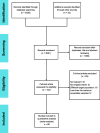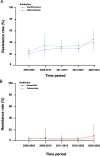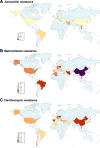Global prevalence of Helicobacter pylori antibiotic resistance among children in the world health organization regions between 2000 and 2023: a systematic review and meta-analysis
- PMID: 39710669
- PMCID: PMC11664859
- DOI: 10.1186/s12916-024-03816-y
Global prevalence of Helicobacter pylori antibiotic resistance among children in the world health organization regions between 2000 and 2023: a systematic review and meta-analysis
Abstract
Background: Helicobacter pylori infection causes gastritis, peptic ulcers, and gastric cancer. The infection is typically acquired in childhood and persists throughout life. The major impediment to successful therapy is antibiotic resistance. This systematic review and meta-analysis aimed to comprehensively assess the global prevalence of antibiotic resistance in pediatric H. pylori infection.
Methods: We performed a systematic search of publication databases that assessed H. pylori resistance rates to clarithromycin, metronidazole, levofloxacin, amoxicillin, and tetracycline in children. The WHO region classification was used to group pooled primary and secondary resistance estimates along with 95% confidence interval (CI). H. pylori antibiotic resistance rates were retrieved and combined with odds ratios (95% CI) to investigate the global prevalence and temporal trends. Subgroup analysis of the prevalence of antibiotic resistance was conducted by country, age groups, and susceptibility testing methods.
Results: Among 1417 records obtained initially, 152 studies were selected for eligibility assessment after applying exclusion criteria in multiple steps. Ultimately, 63 studies involving 15,953 individuals were included comprising data from 28 countries in 5 WHO regions. The primary resistance rates were metronidazole 35.3% (5482/15,529, 95% CI: 28.7-42.6), clarithromycin 32.6% (5071/15,555, 95% CI: 27.7-37.9), tetracycline 2.1% (148/7033, 95% CI: 1.3-3.6), levofloxacin 13.2% (1091/8271, 95% CI: 9.3-18.4), and amoxicillin 4.8% (495/10305, 95% CI: 2.5-8.8). Raising antibiotic resistance was detected in most WHO regions.
Conclusions: The escalating trend of H. pylori antibiotic resistance in children warrants urgent attention globally. National and regional surveillance networks are required for antibiotic stewardship in children infected with H. pylori.
Keywords: Helicobacter pylori; Antibiotic resistance; Children; Epidemiology; Meta-analysis; WHO region.
© 2024. The Author(s).
Conflict of interest statement
Declarations. Ethics approval and consent to participate: Not applicable. Consent for publication: Not applicable; this manuscript does not include any details, images, or videos relating to an individual person. Competing interests: The authors declare no competing interests.
Figures



References
-
- Hooi JKY, Lai WY, Ng WK, Suen MMY, Underwood FE, Tanyingoh D, Malfertheiner P, Graham DY, Wong VWS, Wu JCY, et al. Global prevalence of Helicobacter pylori infection: systematic review and meta-analysis. Gastroenterology. 2017;153(2):420–9. - PubMed
-
- Yuan C, Adeloye D, Luk TT, Huang L, He Y, Xu Y, Ye X, Yi Q, Song P, Rudan I. The global prevalence of and factors associated with Helicobacter pylori infection in children: a systematic review and meta-analysis. Lancet Child Adolesc Health. 2022;6(3):185–94. - PubMed
-
- Šamanić I, Dadić B, Sanader Maršić Ž, Dželalija M, Maravić A, Kalinić H, Vrebalov Cindro P, Šundov Ž, Tonkić M, Tonkić A et al: Molecular characterization and mutational analysis of clarithromycin- and levofloxacin-resistance genes in Helicobacter pylori from gastric biopsies in Southern Croatia. In: International Journal of Molecular Sciences. vol. 24; 2023. - PMC - PubMed
Publication types
MeSH terms
Substances
LinkOut - more resources
Full Text Sources
Medical

